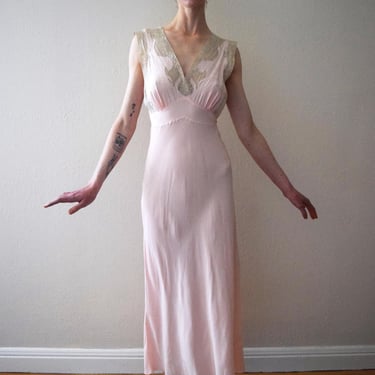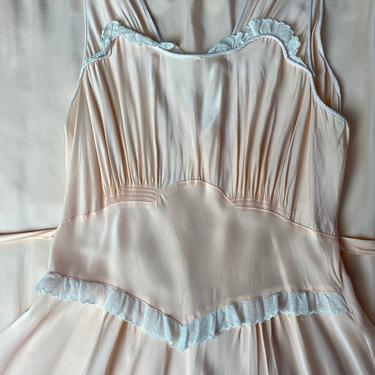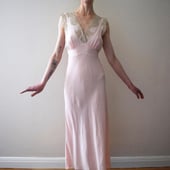- ATTIC
- San Francisco
- Fashion
- Product
ATTIC is a search and discovery engine that helps you find furniture, home decor and fashion products from small, independent stores, dealers and makers. Our core service is free for all to use. We may earn a commission when you buy through links on our site. Learn more about ATTIC

1940s bias cut gown . vintage rayon and lace slip dress . size xs to small

A vintage 1940s bias cut gown with inset lace on the front and back bodice, attached waist ties, and and embroidered floral and leaf pattern ...
$$$$$ · Indexed December 11, 2024 · Source
etsy.com
Content may be subject to copyright. Terms of Use
ATTIC Availability Predictor beta

We are unable to confirm this product's availability. Please contact the seller directly.
Blue Fennel ·
San Francisco, CA
Usage
- Ideal for special occasions where elegance and vintage charm are desired, such as weddings or themed parties.
- Can serve as a unique addition to a vintage wardrobe, allowing for expressive personal style.
- Offers a nostalgic option for costume events or film productions set in the 1940s, enhancing authenticity in character portrayal.
History
- Vintage gowns from the 1940s often reflect the post-war fashion revolution, showcasing a blend of practicality and femininity that defined the era.
- The use of bias cut in dressmaking gained popularity in the 1930s and 1940s, allowing garments to fit the body's natural curves and shape elegantly.
- Rayon was a common fabric in the mid-20th century, chosen for its softness and luxurious feel, resembling silk at a more affordable price point.
Design Significance
- The incorporation of lace elements can signify a transitional style that blends romanticism with the practicality of everyday wear during the 1940s.
- Bias cut designs are significant in fashion history as they revolutionized how fabric drapes over the body, contributing to a silhouette that flatters a range of body types.
- The embroidered floral and leaf patterns may indicate a nod to natural themes in design, which became increasingly prominent in mid-century fashion.

1940s silk satin and lace bias cut gown . size xs to s/m 1940s silk satin lace bias cut gown size
Product InfoBlue Fennel
San Francisco, CA
Vintage 1930s silk bias cut gown . 30s slip dress . size xxs to xs 1930s silk bias cut gown 30s slip dress size xxs
Product InfoBlue Fennel
San Francisco, CA
1940s bias cut gown . vintage silk nightgown . size small to s/m 1940s bias cut gown silk nightgown size small
Product InfoBlue Fennel
San Francisco, CA
40’s peachy slip dress~ bias cut yummy cold rayon 1940s bombshell beautiful draping gown lace ruffle ruching nighty sexy nightgown 40s peachy slip dress bias cut yummy cold rayon 1940s bombshell draping gown lace ruffle ruching nighty sexy nightgown
Product InfoHatties Vintage Clothing
Portland, OR
Vintage 90’s Black Silk Lace Bias Cut Slip Gown / ML 90s black silk lace bias cut slip gown
Product InfoXtabay Vintage
Portland, OR
Vintage Black Silk Charmeuse & Lace Bias Cut Slip Gown / ML black silk charmeuse lace bias cut slip gown
Product InfoXtabay Vintage
Portland, OR
Usage
- Ideal for special occasions where elegance and vintage charm are desired, such as weddings or themed parties.
- Can serve as a unique addition to a vintage wardrobe, allowing for expressive personal style.
- Offers a nostalgic option for costume events or film productions set in the 1940s, enhancing authenticity in character portrayal.
History
- Vintage gowns from the 1940s often reflect the post-war fashion revolution, showcasing a blend of practicality and femininity that defined the era.
- The use of bias cut in dressmaking gained popularity in the 1930s and 1940s, allowing garments to fit the body's natural curves and shape elegantly.
- Rayon was a common fabric in the mid-20th century, chosen for its softness and luxurious feel, resembling silk at a more affordable price point.
Design Significance
- The incorporation of lace elements can signify a transitional style that blends romanticism with the practicality of everyday wear during the 1940s.
- Bias cut designs are significant in fashion history as they revolutionized how fabric drapes over the body, contributing to a silhouette that flatters a range of body types.
- The embroidered floral and leaf patterns may indicate a nod to natural themes in design, which became increasingly prominent in mid-century fashion.
ATTIC is a search and discovery engine that helps you find furniture, home decor and fashion products from small, independent stores, dealers and makers. Our core service is free for all to use. We may earn a commission when you buy through links on our site. Learn more about ATTIC
Still looking? Search stores near San Francisco or anywhere in the world.





















